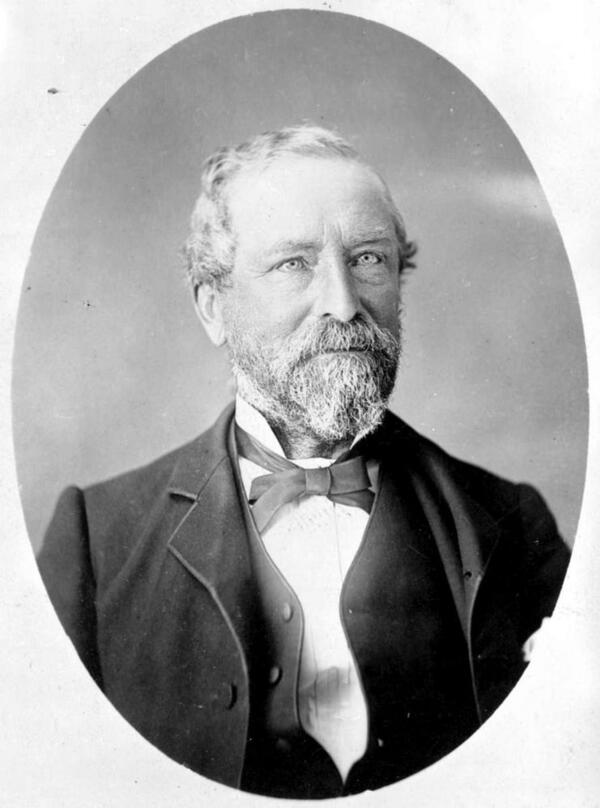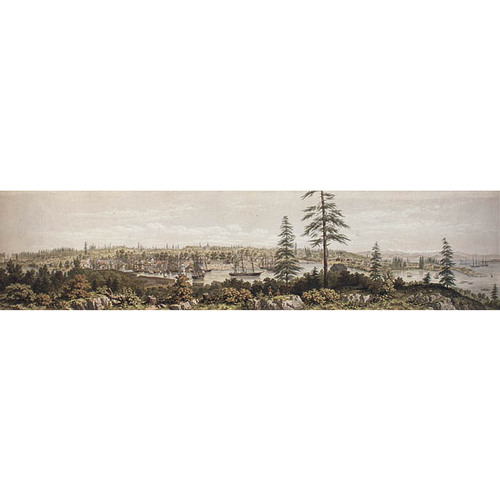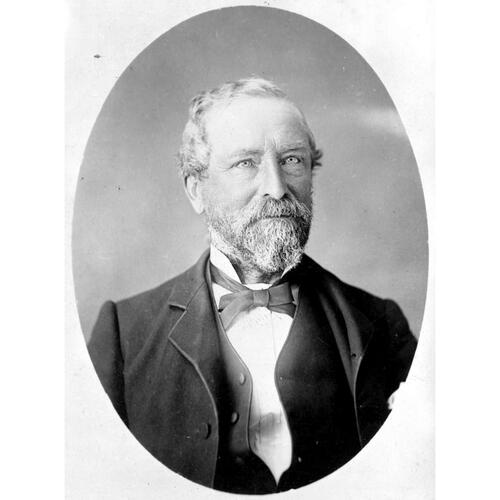
Source: Link
TIEDEMANN, HERMANN OTTO, architect, civil engineer, and surveyor; b. 1821 in Berlin; m. 13 Aug. 1861 Mary Bissett of Victoria (B.C.), and they had one son; d. there 12 Sept. 1891.
Educated as an architect and civil engineer in Berlin, Hermann Otto Tiedemann immigrated to Vancouver Island in 1858 and became the recently founded colony’s first professional architect. Whether drawn there by opportunity or by specific contacts, he worked as assistant and principal draftsman to the colonial surveyor, Joseph Despard Pemberton, from the summer of 1858. The following year he was commissioned to design the legislative buildings, to be erected near the site of Fort Victoria (Victoria). Formally disposed around the central House of Assembly, the complex of six brick and wood structures was completed by 1864 at a cost of $38,719. It was used by the legislature until Francis Mawson Rattenbury*’s grandiose replacement was completed in 1898, and was destroyed by fire in 1957. In his legislative buildings Tiedemann’s eccentric and eclectic style, deriving from American and European picturesque conventions, distracted from his architectural competence. In June 1859 the Victoria Gazette dismissed his designs with the enduring sobriquet of “fancy bird-cages” and, in an editorial in the British Colonist on 26 August, Amor De Cosmos described the proposed buildings as “something between a Dutch Toy and a Chinese Pagoda.” During the same period Tiedemann probably designed the earliest lighthouses on the west coast, constructed at Fisgard Island and Race Rocks in 1859–60. The contractor’s drawings are not signed by him but, upon the opening of the Fisgard lighthouse, the British Colonist reported that the “design was made by Mr. Tiedemann.”
On 3 March 1862 Tiedemann resigned his post with the surveyor general in order to undertake, on behalf of Alfred Penderell Waddington*, a study of the feasibility of constructing a wagon road from Bute Inlet off the Strait of Georgia to Fort Alexandria (Alexandria, B.C.). He paddled out of Victoria through James Bay on 16 May with seven others and, according to his own report, reached the fort on 25 June “reduced to a skeleton, unable to walk.” A plank road was built in 1863–64, incorporating his idea of traversing canyons with rock-filled suspended cribs. When he returned to Victoria, he participated in an attempt to pipe water into the city from Elk Lake, worked for the Puget’s Sound Agricultural Company in the laying of the Esquimalt Road in 1864, and advised the government in 1866 about the control of the Leech River near Sooke. Of greater economic significance was his survey in September 1865 of the coal deposits north of Nanaimo.
He continued to practise architecture, undertaking domestic and commercial work in Victoria, and such notable commissions as St Andrew’s Church (Presbyterian) in 1869 and the grander Gothic Revival Anglican cathedral, originally designed in stone but built in wood (1871–72). The cathedral was praised in the Daily British Colonist for its aesthetic distinction despite “the consumptive look” of its tower. Neither of these structures survives. In May 1872 Tiedemann was appointed by the Canadian government to command one of the parties under the authority of Peter O’Reilly* seeking a route in the Chilcotin for the proposed Canadian Pacific Railway. Between 18 June and 5 November he retraced much of the survey he had completed in that district in 1862 and built a trail through the Homathko River bluffs. A creek, glacier, and mountain in the region bear his name. In 1873 his architectural career continued with his design, in a German-influenced Queen Anne Revival style, for the Roller Flour and Rice Mills on Victoria’s Store Street. Other commercial contracts followed, including a large warehouse on Wharf Street in 1878. They culminated in 1882 in the handsome arcaded Finlayson Building on the same street, with the earliest major cast-iron front in western Canada. His last important commission was the new provincial courthouse (1887–88), later altered by Rattenbury. Symmetrically designed with Italianate Revival detail, this harmoniously scaled brick structure cost $35,075. It was hailed by the Daily Colonist as a “lasting monument to the progress which the province is making in architecture.”
Though less accomplished than his celebrated successors Rattenbury and Samuel Maclure*, Tiedemann helped establish sophisticated stylistic and technical standards for architecture in Victorian British Columbia.
Records relating to Hermann Otto Tiedemann’s work as an architect and surveyor are preserved in the PABC. Several of his artistic works are in the PABC’s Visual Records Division, including a lithograph and sketch of Victoria (pdp 226 and 227 respectively) and three water-colours (pdp 457, 2232, 3661).
PABC, C/AA/30.7K/T44; E/B/T44; E/C/T441; GR 1372, F 583, no.1; F 903, no.26; F 904, no.14; F 905, no.22; F 909, no.23; F 1703. Alexander Begg, History of British Columbia from its earliest discovery to the present time (Toronto, 1894; repr. 1972). Journals of the colonial legislatures of the colonies of Vancouver Island and British Columbia, 1851–1871, ed. J. E. Hendrikson (5v., Victoria, 1980). British Colonist (Victoria), 26 Aug. 1859, 9 June 1860. Cariboo Sentinel (Barkerville, B.C.), 31 Aug. 1872. Daily British Colonist (Victoria), 28 Nov. 1862; 11 May, 18 Oct. 1865; 22 June 1871; 21 Jan., 30 May, 7 June, 20 Oct. 1872; 2 Jan. 1875; 29 Dec. 1876; 30 Jan. 1878; 1–2 Feb. 1879. Daily Colonist (Victoria), 28 Oct. 1888, 13 Sept. 1891. Gazette (Victoria), 23 June 1859. B.C. directory, 1863. Terry Kobayashi and Michael Bird, A compendium of Canadian folk artists (Erin, Ont., 1985). Victoria directory, 1860, 1868–74. A. A. Barrett and R. W. Liscombe, Francis Rattenbury and British Columbia: architecture and challenge in the imperial age (Vancouver, 1983). The British Columbia parliament buildings, ed. Martin Segger (Vancouver, 1979). E. F. Bush, The Canadian lighthouse (Parks Can., National Hist. Parks and Sites Branch, Manuscript report, no.58, Ottawa, 1970). C. P. de Volpi, British Columbia: a pictorial record; historical prints and illustrations of the province of British Columbia, Canada, 1778–1891 ([Toronto], 1973). J. R. Harper, A people’s art: primitive, naive, provincial, and folk painting in Canada (Toronto and Buffalo, N.Y., 1974). Adrian Kershaw and J. [D.] Spittle, The Bute Inlet route: Alfred Waddington’s wagon road, 1862–1864 (Kelowna, B.C., 1978). S. M. Lambeth and S. L. Jeune, A history of Fisgard Lighthouse and the west coast lighthouse system to 1920 (Parks Can., National Hist. Parks and Sites Branch, Manuscript report, no.356, Ottawa, 1980). Martin Segger and Douglas Franklin, Victoria: a primer for regional history in architecture (Watkins Glen, N.Y., and Victoria, 1979). Dorothy Blakey Smith, “Fort Victoria, 1859,” B.C. Teacher (Vancouver), 38 (1958): 176. G. Castle, “Munich flavour to former courthouse building,” Times-Colonist, 17 Dec. 1983. “Founders of B.C.: Hermann Tiedemann,” Victoria Daily Times, 1 Nov. 1967. W. A. D. Munday, “A Coast Range pioneer,” Canadian Alpine Journal (Winnipeg), 32 (1949): 42–49. J. [K.] Nesbitt, “Old homes and families,” Daily Colonist, 9 Nov. 1952.
Bibliography for the revised version:
City of Victoria Arch., “Town of Victoria, Vancouver Island, from the official map, 1861”: archives.victoria.ca/town-of-victoria-vancouver-island-from-the-official-map (consulted 4 Sept. 2024).
Cite This Article
R. Windsor Liscombe, “TIEDEMANN, HERMANN OTTO,” in Dictionary of Canadian Biography, vol. 12, University of Toronto/Université Laval, 2003–, accessed March 30, 2025, https://www.biographi.ca/en/bio/tiedemann_hermann_otto_12E.html.
The citation above shows the format for footnotes and endnotes according to the Chicago manual of style (16th edition). Information to be used in other citation formats:
| Permalink: | https://www.biographi.ca/en/bio/tiedemann_hermann_otto_12E.html |
| Author of Article: | R. Windsor Liscombe |
| Title of Article: | TIEDEMANN, HERMANN OTTO |
| Publication Name: | Dictionary of Canadian Biography, vol. 12 |
| Publisher: | University of Toronto/Université Laval |
| Year of publication: | 1990 |
| Year of revision: | 2025 |
| Access Date: | March 30, 2025 |




